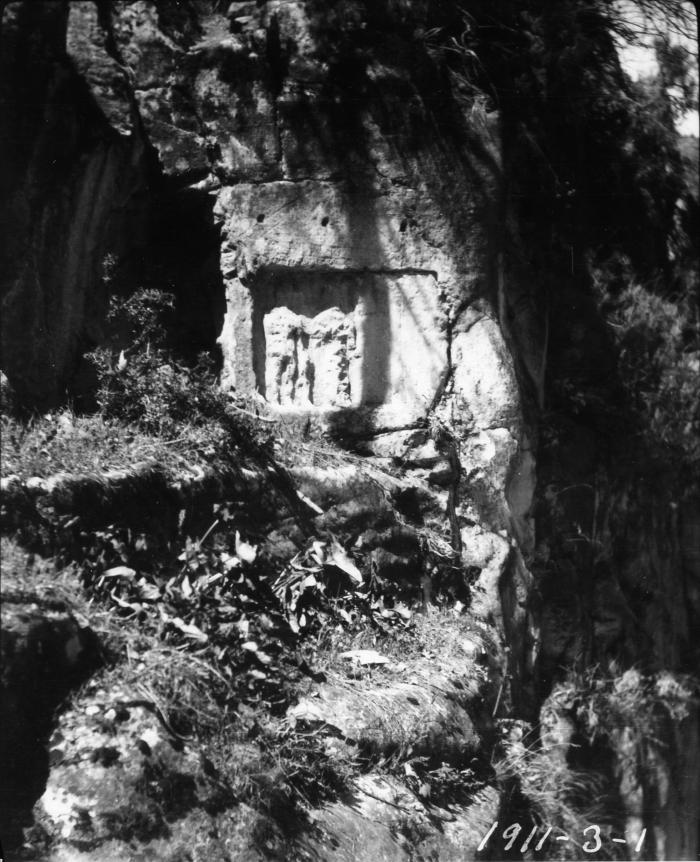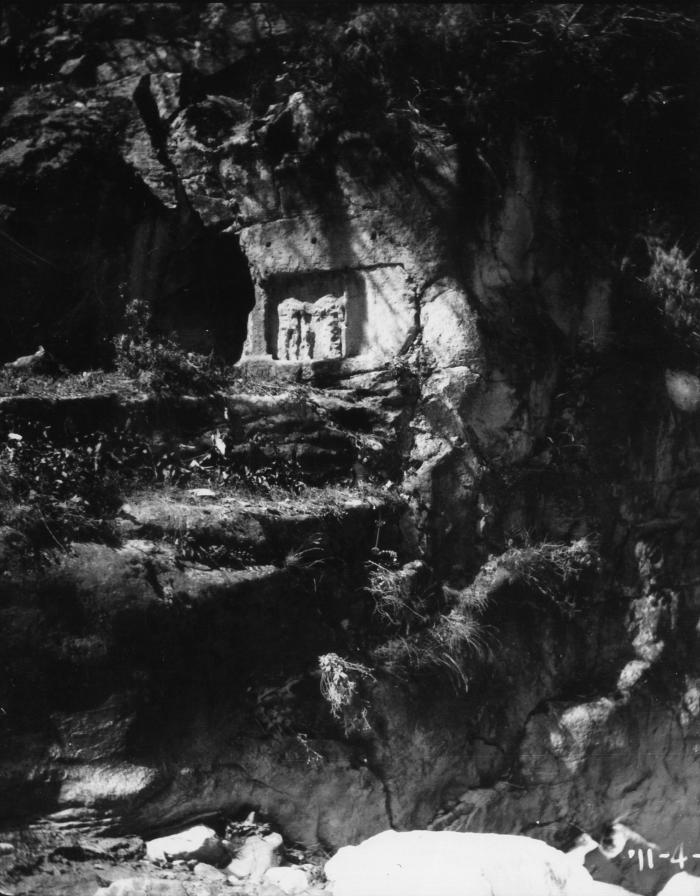İki Ön Figürlü Rock-Relief Aedicula
- Dönem
- 3rd-2nd C. BC, Hellenistik
- Sardeis veya Müze Env. No.
- Uninv. R2, Cat. 156
- Malzeme
- Mermer, Taş
- Eserin Türü
- Heykel
- Heykelin Türü
- Votif Kabartması, Naiskos
- Yerleşim
- Sardis
- Bulunduğu Yeri
- S of AT on the W bank of the Mağara Deresi gorge ca. 100 m. S of quarry 1 in the designations (supra Ch. 1), ca. 60 m. S of a bend in the torrent, ca. 3 m. above torrent bed. The relief is located at the juncture of the E quarry face, which runs parallel to the torrent, and the rising quarried E-W wall which faces S. The relief faces SE. Slightly above and to the r. of the relief is a deeply graven small swastika (0.50 E from top of pediment and 0.13 above it).
- Tanım
The architectural frame consists of a rather steeply pitched pediment outlined on the rock with rows of points. Underneath the pediment is a row of (originally 16?) rectangles alternately projecting and recessed; 8 raised and 4 recessed rectangles survive, intended either as oversized dentils or as small Doric metopes. Even before 1975, the l. side of the vertical support was gone. The r. side consists of a thin Ionic pilaster, which has one volute on the l. side. A nice caduceus (Hermes' wand) is incised halfway up on the face.
There are two rectangular dowel holes (ca. 0.03 by 0.025; D. 0.04), one in the center of the pediment and one to the r. at the same H., as if something had been fastened horizontally. Two round holes (diam. 0.01; D. 0.04) appear on both sides of the center below the dentils, ca. 0.30 apart.
The relief panel is markedly recessed. The l. figure is now indecipherable; from earlier sketches and a color slide it appears to be a frontal male, possibly with a cloak or skin thrown from the l. shoulder to the r. hip and holding a stick (?) or club with his l. hand. Herakles, whose club appears prominently on Sardian Hellenistic coins and whose adventures were linked with Sardis at an early date, would fit the indistinct outline best; but the caduceus on the pier of the aedicula suggests Hermes as a possible alternative.
The r. figure is a goddess in a long dress. What is extant at the bottom of the dress shows that two little feet emerged from the drapery. She wears a crown; the outline of the crown and the termination of the hair can be discerned on her r. shoulder. Her r. arm was bent and held something: an animal is possible but the surface permits no certainty. Her l. arm hung down below the body, the forearm coming forward at an angle to touch the pillar standing next to her. This pillar recedes obliquely; the turn from front to diagonal plane is not sharp, as in good Hellenistic reliefs (cf. Cat. 135 Figs. 269-270), but rounded. At shoulder level to the goddess a line of deep dots, done with the point, goes across the pillar, probably to designate its top. Above the line is a vague spreading form, perhaps intended as a basket; and above that is an indistinct mass with some point-dots, possibly intended for an acanthus-like floral growth.
The goddess is apparently designed to represent an archaic image. If she held a lion, she would be Kuvava (Cybele); if the object on the pillar is a blooming plant, she might be the Kore of Sardis. Too much of the surface is lost to permit identification.
The relief was never elaborate. If the rectangles are intended as Doric metopes, the relief cannot be earlier than Hellenistic. A certain nicety and precision in the drawing of the architecture weigh in favor of a Hellenistic rather than Roman date. Like the small Madonnas and crucifixes in Catholic countries, it probably served as a small shrine receiving the devotions of marble workers in the quarry. Conceivably, it might have been made at the time when marble was being quarried for the Hellenistic Temple of Artemis (ca. 250 B.C. on?).
- Condition
Cut into native white marble wall at Magara Deresi quarry. The relief was first reported by R. H. Whallon in 1960. It was photographed in color by C. H. Greenewalt, Jr. in 1974. It was damaged sometime before July 1975, when it was seen by Nuşin Asgari. The present description was made by C. H. Greenewalt and G.M.A. Hanfmann on Aug. 27, 1975.
Original surface weathered gray and yellow and quite indistinct. Recent (1975) breaks are white. Recent damage: I. corner of pediment, more than half of relief panel broken off. Of the figure on the I. only the outline of head, neck, and shoulders remains.
- Boyutlar
- Total max. H. 1.05; H. of panel with figures 0.65, of pediment 0.285; P.W . of aedicula 0.60.
- Yorum
- For the type of archaic goddess with polos cf. Cat. 3 and Cat. 194 (Figs. 9-10, 344). Coins with club of Herakles (Apollo-club, Herakles-Apollo) and myths of Herakles will be discussed in the catalogue of Greek coins by A. E. M. Johnston in a forthcoming volume in this series Sardis M7. She will also treat the representations of Kore.
- Ayrıca bakınız
- Kaynakça
- Yazar
- NHR


